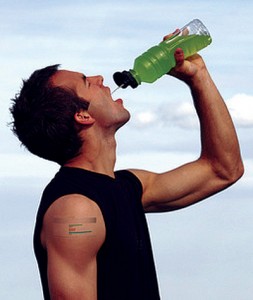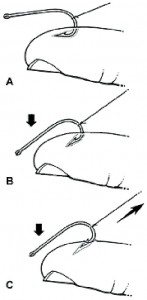Be Prepared To Deal With Summertime Emergencies
By Dr. Mike McGoohan // March 7, 2015
HELPFUL TIPS TO STAY SAFE THIS SUMMER
ABOVE VIDEO: As many as 1,000 swimmers were stung by jellyfish at Cocoa Beach over the Memorial Day weekend in 2011. It was said that the swarm was so thick that anyone wading into the ocean was likely to get stung. Steve Gehlbach of the FOX News Channel delivers the details, including what to do if you get stung.
BREVARD COUNTY • COCOA BEACH, FLORIDA — The Space Coast–the ocean, the river, surfing, fishing or a family day at the beach is what summertime is all about in Florida. Along with the fun comes some health risks due to environmental and marine life exposure. Here are a few of the most common problems that we see in the Emergency Departments with some helpful tips for treatment.
SUNBURN

The most important issue with sunburn is PREVENTION! Utilization of hats, sunglasses, sun protective clothing, and good sun block are essential methods of prevention.
If you do get a “burn”, here are some basic tips:
- Get to a cool place and apply cool water compresses to the affected skin.
- Consider an analgesic like ibuprofen or aspirin for pain control and inflammation.
- Frequent application of topical therapy with creams and gels will help to provide relief.
- For ruptured blisters you may gently remove dead skin, keep clean with soap and water, and apply an antibiotic cream or ointment.
The pharmacies designate an entire area to first aid treatment for sunburn. In the event of extensive burns, deep burns, inadequate pain control, dehydration, or feeling generally unwell it would be prudent to present to the Emergency Department for evaluation.
HEAT ILLNESS & DEHYDRATION
As with sunburn, the key is PREVENTION! The risks for heat illness and dehydration are highest in the very young and the elderly, especially in those who have other medical problems or are taking certain medications. Avoid prolonged heat exposure and stay hydrated with water and electrolyte containing fluids.

Heat illness is a range of illnesses from heat rash, to heat cramps, to heat exhaustion, to a life-threatening condition called heat stroke. For minor symptoms such as fatigue, nausea, mild cramps, lightheadedness, you would be safe to get to a cool environment and re-hydrate with an electrolyte containing fluid. Again, most stores and pharmacies have an extensive list of fluid options.
For more severe symptoms such as severe headache, fainting, persistent vomiting, profound weakness, or confusion, it is best to go to an Emergency Department for evaluation and treatment. Also, in this section I would mention kidney stones, as we see a large amount of these cases in the summer associated with dehydration. If you have ever had the misfortune of experiencing this condition you would be willing to do most anything to avoid one. If you are a stone former pay particular attention to staying well hydrated in the summer.
JELLYFISH
The Portuguese Man of War is the sting nemesis for swimmers and divers in Florida waters on the beach and off shore. Do not play nor let your child play with the “blue balloons at the beach!” The tentacles beneath the balloon are what cause the stings.

If exposed, carefully remove the tentacles, taking care not to expose yourself further. If envenomed, you will experience pain and stinging at the site of contact. De-activate the toxin with vinegar or isopropyl (rubbing) alcohol.
We prefer vinegar and typically apply it as a wet compress or repeated sprays. You may smell like an Easter egg coloring session, but you will appreciate the relief it provides. Thereafter, the application of a soothing skin cream or hydrocortisone will combat the discomfort and help with the rash. There are rare occasions in which you can get a more severe generalized allergic reaction. If that occurs I would suggest evaluation through the Emergency Department.
STINGRAY & CATFISH
Both stingrays and catfish can cause puncture wound injuries and envenomation. These wounds hurt badly and do carry some real risks of problems. Avoid these fish and try not to handle them at all if possible.

The spines of the stingray are on the body at the base of the tail. Most injuries are to the feet and ankles and occur when you step on them. Their tail flips up to cause a puncture wound.
Catfish spines are located in the dorsal and pectoral fins, and most injuries occur to the upper extremity when handling the fish.
For both of these, immediate treatment with submersion of the affected anatomic area in hot water will deactivate the toxin and cause immediate pain relief. Most injuries, except the most minor punctures, should be seen in an Emergency Department. The reason is threefold:
- Tetanus immunization may need to be updated
- These punctures will many times have a piece of bony spine retained within the wound
- There is a high risk of infection if left untreated.
In the Emergency Department we will typically x-ray the area looking for a retained spine and remove if present, clean thoroughly, and prescribe antibiotics preventatively.
FISH HOOKS
Getting “hooked” is a very common occurrence for year-round anglers here in Florida, so fishhook removal is a fairly common procedure performed in the Emergency Department.
 Various removal techniques can be used, but here is one that may be achievable in the field and keep you fishing. In the “string pull” technique (shown at right) a string is looped around the hook and then firmly tugged while simultaneously placing downward pressure on the shank. I would not recommend this technique if you suspect the hook to be very deep, embedded in vital structures like tendons or vessels, or in loose skin areas like eyelids or lips.
Various removal techniques can be used, but here is one that may be achievable in the field and keep you fishing. In the “string pull” technique (shown at right) a string is looped around the hook and then firmly tugged while simultaneously placing downward pressure on the shank. I would not recommend this technique if you suspect the hook to be very deep, embedded in vital structures like tendons or vessels, or in loose skin areas like eyelids or lips.
Keep these wounds clean to avoid infection and update your tetanus immunization if needed. Tetanus immunization is typically updated within five years for dirty wounds/puncture wounds and ten years for clean wounds.
Summertime on the Space Coast offers recreational opportunities. Stay safe and make sure you know how to recognize and best manage some of the common health risks associated with summertime fun.
ABOUT THE AUTHOR

Dr. McGoohan graduated from med school at Nova/Southeastern in Miami and did his Emergency Medicine Residency at LSU Charity Hospital in New Orleans. Board Certified in Emergency Medicine, Managing Partner of Space Coast Emergency Physicians and Medical Director of the Emergency Dept. at Viera Hospital, he was also previously Medical Director of Emergency Services and past president of the medical staff at Cape Canaveral Hospital. He is a 20-year resident of our community and enjoys the Space Coast lifestyle with his wife Linda, son Dale, and daughter Emily.












